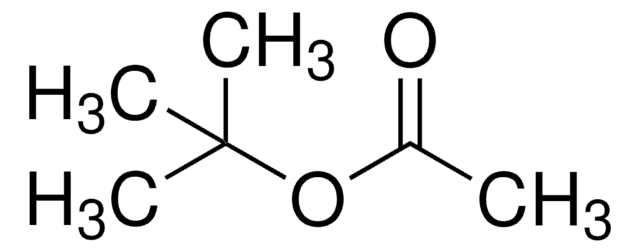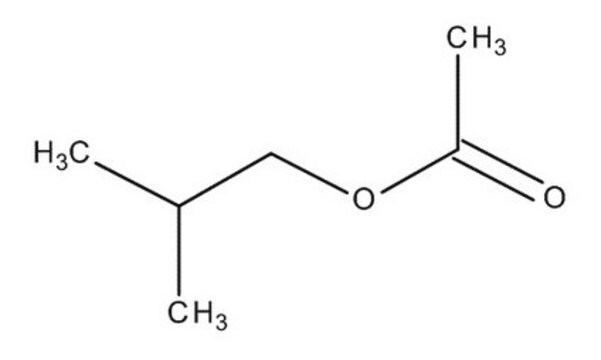402842
Butylacetat
ACS reagent, ≥99.5%
About This Item
Empfohlene Produkte
Qualität
ACS reagent
Qualitätsniveau
Dampfdichte
4 (vs air)
Dampfdruck
15 mmHg ( 25 °C)
8 mmHg ( 20 °C)
Assay
≥99.5%
Form
liquid
Selbstzündungstemp.
790 °F
Expl.-Gr.
7.6 %
Methode(n)
tissue processing: suitable
Verunreinigungen
H2SO4, passes test (darkened)
≤0.0016 meq/g Titr. acid
≤0.1% water
≤0.2% C4H9OH
Abdampfrückstand
≤0.001%
Farbe
APHA: ≤10
Brechungsindex
n20/D 1.394 (lit.)
pH-Wert
6.2 (20 °C, 5.3 g/L)
bp
124-126 °C (lit.)
mp (Schmelzpunkt)
−78 °C (lit.)
Dichte
0.88 g/mL at 25 °C (lit.)
SMILES String
CCCCOC(C)=O
InChI
1S/C6H12O2/c1-3-4-5-8-6(2)7/h3-5H2,1-2H3
InChIKey
DKPFZGUDAPQIHT-UHFFFAOYSA-N
Suchen Sie nach ähnlichen Produkten? Aufrufen Leitfaden zum Produktvergleich
Allgemeine Beschreibung
Anwendung
Signalwort
Warning
H-Sätze
Gefahreneinstufungen
Flam. Liq. 3 - STOT SE 3
Zielorgane
Central nervous system
Zusätzliche Gefahrenhinweise
Lagerklassenschlüssel
3 - Flammable liquids
WGK
WGK 1
Flammpunkt (°F)
80.6 °F - closed cup
Flammpunkt (°C)
27 °C - closed cup
Analysenzertifikate (COA)
Suchen Sie nach Analysenzertifikate (COA), indem Sie die Lot-/Chargennummer des Produkts eingeben. Lot- und Chargennummern sind auf dem Produktetikett hinter den Wörtern ‘Lot’ oder ‘Batch’ (Lot oder Charge) zu finden.
Besitzen Sie dieses Produkt bereits?
In der Dokumentenbibliothek finden Sie die Dokumentation zu den Produkten, die Sie kürzlich erworben haben.
Kunden haben sich ebenfalls angesehen
Unser Team von Wissenschaftlern verfügt über Erfahrung in allen Forschungsbereichen einschließlich Life Science, Materialwissenschaften, chemischer Synthese, Chromatographie, Analytik und vielen mehr..
Setzen Sie sich mit dem technischen Dienst in Verbindung.







